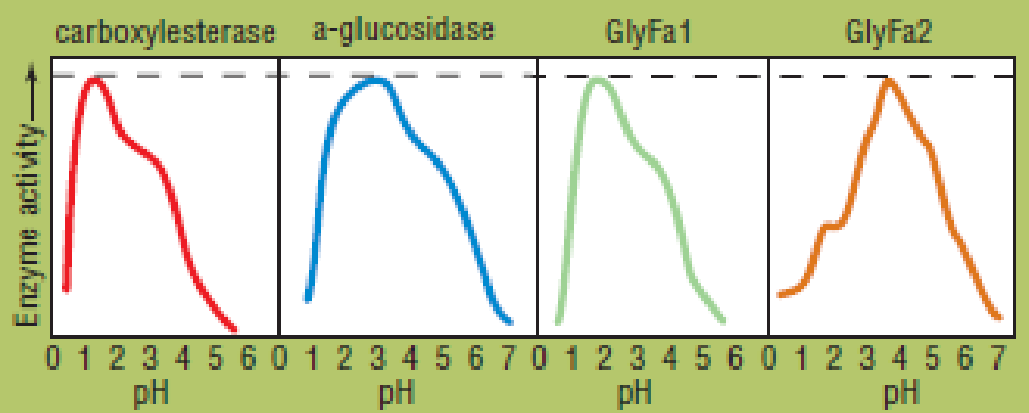
Concept explainers
The genus Ferroplasma consists of a few species of acid-loving archaea. One species, F. acidarmanus, was discovered to be the main component of slime streamers (a type of biofilm) deep inside an abandoned California copper mine (Figure 4.11A).
F. acidarmanus cells use an ancient energy-harvesting pathway that combines oxygen with iron–sulfur compounds in minerals such as pyrite. This reaction dissolves the minerals, so groundwater that seeps into the mine ends up with extremely high concentrations of metal ions such as copper, zinc, cadmium, and arsenic. The reaction also produces sulfuric acid, which lowers the pH of the water around the cells to zero.
Despite living in an environment with a composition similar to hot battery acid, F. acidarmanus cells maintain their internal pH at a cozy 5.0. Thus, researchers investigating Ferroplasma

A. Deep inside one of the most toxic sites in the United States: Iron Mountain Mine, in California. The water in this stream, which is about 1 meter (3 feet) wide in this photo, is hot (around 40°C, or 104°F), heavily laden with arsenic and other toxic metals, and has a pH of zero. Slime streamers growing in it are a biofilm dominated by a species of archaea, Ferroplasma acidarmanus.

B. pH profiles of four enzymes isolated from F. acidarmus. Researchers had expected these enzymes to function best at the cells’ cytoplasmic pH (5.0).
What does the dashed line signify?
Trending nowThis is a popular solution!

Chapter 4 Solutions
Biology Today and Tomorrow without Physiology (MindTap Course List)
- Which of these statements is/are TRUE? A) In general, species that can grow at higher temperatures are prokaryotic. B) The most thermophilic prokaryotes are species of Archaea. C) Chemoorganotrophic organisms are able to grow at higher temperatures than phototrophic organisms. D) All of the statements are true.arrow_forwardWhich is true regarding bacterial and archaea species that use nitrogen and sulfur compounds in different ways? A) O Sulfate-reducing bacteria are those that respire anaerobically using sulfate. B) O Nitrifying bacteria are lithotrophs that produce nitrite and nitrate. C) O Denitrifying bacteria are those that respire anaerobically using various oxidized forms of nitrogen. D) O Sulfur oxidizing bacteria are lithotrophs that obtain energy from sulfur compounds either aerobically or anaerobically E) O All the above are true.arrow_forwardA chemolithoautotroph is respiring using only iron (Fe3+) and nitrite (NO2-). This bacterium does not consume organic molecules. How does this organism make proton motive force?arrow_forward
- The non-protein component of the transmembrane complex used by the salt-loving archaeobacterium Halobacterium halobium, which uses sunlight to create a proton gradient for ATP synthesis, is called: bacteriochlorophyll chlorophyll bacteriorhodopsin retinal cytochrome carrow_forwardWhich of the following statements is false regarding the electron donors in prokaryotic metabolism? A) O The use of organic compounds as electron donors is known as chemo-organotrophy. B) OLithotrophy refers to the use of inorganic molecules as electron sources. C) O Photolysis of water provides electrons to phototrophic organisms such as cyanobacteria. D) O Electrons can be obtained from inorganic chemicals such as H2S. E) O Oxygen can serve as an electron donor.arrow_forwardThe protein component of the transmembrane complex used by the salt-loving archaeobacterium Halobacterium halobium, which uses sunlight to create a proton gradient for ATP synthesis, is called: bacteriochlorophyll chlorophyll bacteriorhodopsin retinal cytochrome carrow_forward
- Clostridium perfringens bacteria, which can survive and grow on frostbitten human tissues, but only in the complete absence of oxygen gas, are properly categorized as: anaerobic autotrophs facultative autotrophs anaerobic heterotrophs aerobic heterotrophs aerobic autotrophsarrow_forwardWhat is the role of oxygen in aerobic respiration? What type(s) of metabolism can occur in the absence of oxygen? Name two enzymes that are present in obligate aerobes but lacking in obligate anaerobes. What is the function of each enzyme Describe the difference between the appearance of surface and subsurface colonies in a pour plate. If this is the same bacterial species, why do these differences in colonial growth occur?arrow_forwardArchaea that live in an extremely high pH levels are called hyperalkaliphiles. Select one: True Falsearrow_forward
- Only select prokaryotic organisms can harvest energy from food by oxidative phosphorylation, but can do this in the absence of oxygen. These organisms are using: a) Aerobic respiration b) Carbon fixation c) Fermentation d) Anaerobic respiration e) Photophosphorylationarrow_forwardE. coli, a facultative anaerobe, is grown for 24 hours on the same type of solid medium, but under two different conditions: one aerobic, the other anaerobic. The size of the colonies would bea) the same under both conditions.b) larger when grown under aerobic conditions.c) larger when grown under anaerobic conditions.arrow_forwardWhy do chemotrophs have to use oxygen? The definition of chemotrophs is = organisms that gain chemical energy by oxidizing bonds. Do the organisms have to oxidize bonds using oxygen?arrow_forward
 Biology Today and Tomorrow without Physiology (Mi...BiologyISBN:9781305117396Author:Cecie Starr, Christine Evers, Lisa StarrPublisher:Cengage Learning
Biology Today and Tomorrow without Physiology (Mi...BiologyISBN:9781305117396Author:Cecie Starr, Christine Evers, Lisa StarrPublisher:Cengage Learning
